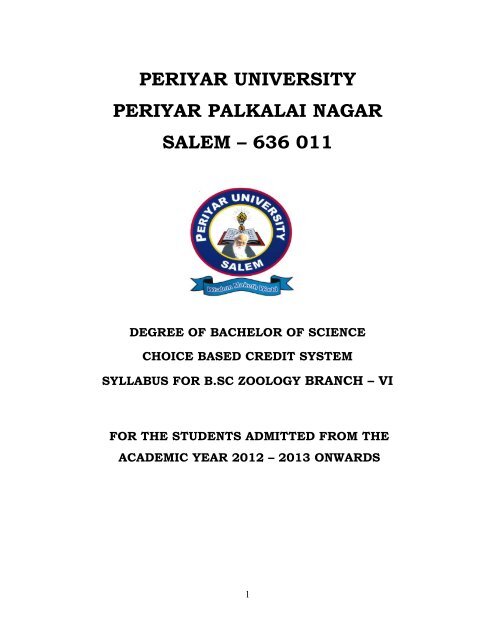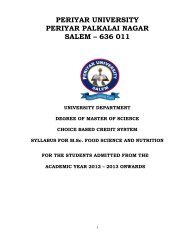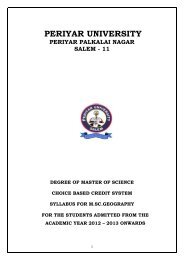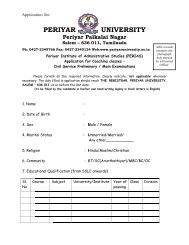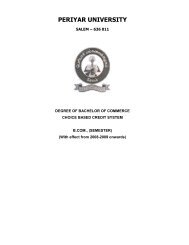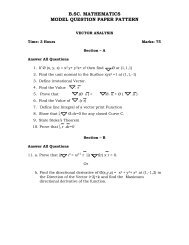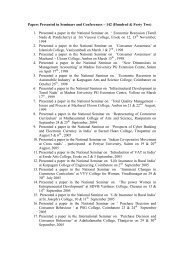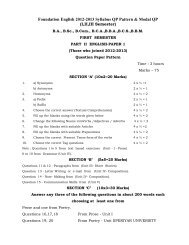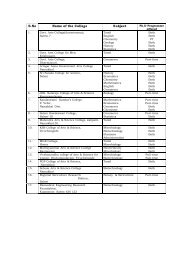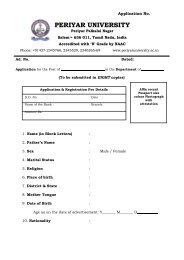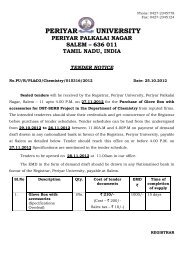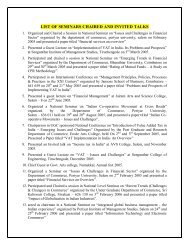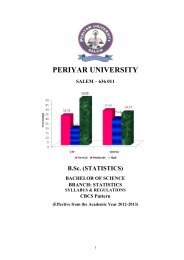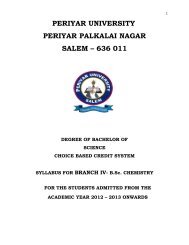B.Sc. Zoology - Periyar University
B.Sc. Zoology - Periyar University
B.Sc. Zoology - Periyar University
You also want an ePaper? Increase the reach of your titles
YUMPU automatically turns print PDFs into web optimized ePapers that Google loves.
PERIYAR UNIVERSITY<br />
PERIYAR PALKALAI NAGAR<br />
SALEM – 636 011<br />
DEGREE OF BACHELOR OF SCIENCE<br />
CHOICE BASED CREDIT SYSTEM<br />
SYLLABUS FOR B.SC ZOOLOGY BRANCH – VI<br />
FOR THE STUDENTS ADMITTED FROM THE<br />
ACADEMIC YEAR 2012 – 2013 ONWARDS<br />
1
AIM AND SCOPE OF THE COURSE:<br />
•To instill knowledge across different areas of animal science.<br />
•Provides an opportunity to familiarize with the life cycles and mode of reproduction in different<br />
animal groups.<br />
• The topics included in different units of different papers would enable the students to develop<br />
technical skills in Zoological and allied branches.<br />
• Skill based subjects like Ornamental fisheries, Fish preservation, and Economic importance,<br />
Sericulture, Apiculture, Aquaculture, Biotechnology, Bioinformatics and Nutrition and Dietetics<br />
have been included in order to provide opportunities in employment and research in Government<br />
and Private organizations.<br />
•There is also scope for self employment for the students.<br />
• Students will understand the importance of the animals in the biosphere.<br />
• Practicals included in the syllabus will improve the skills of the students in Microscopy,<br />
Observations, Drawing and Laboratory techniques.<br />
2
ELIGIBILITY FOR ADMISSION:<br />
Candidate for admission to the first year of the degree of Bachelor of <strong>Sc</strong>ience Course shall<br />
be required to have passed the Higher secondary examination (Academic or Vocational Stream)<br />
conducted by the Government of Tamil Nadu or an Examination accepted by the Syndicate ,<br />
Subject to such conditions may be prescribed therefore shall be permitted to appear and qualify<br />
for B.<strong>Sc</strong> degree examination in <strong>Zoology</strong>.<br />
DURATION OF THE COURSE:<br />
The course for the degree of Bachelor of <strong>Sc</strong>ience shall consist of three academic years divided<br />
in to six semesters. Each semester consists of 90 working days.<br />
PASSING MINIMUM:<br />
The candidate shall b e declared to have passed the examinations if he /she secures not less than<br />
40 marks.<br />
DISTRIBUTION OF MARKS:<br />
THEORY<br />
<strong>University</strong> examination = 75 marks<br />
Internal assessment = 25 marks<br />
Internal assessment structure:<br />
Test = 15 marks<br />
Assignments = 05 marks<br />
Attendance = 05 marks<br />
Passing minimum for Internal Assessment = 10 marks<br />
Passing minimum of r <strong>University</strong> examinations = 30 marks<br />
3
PRACTICALS<br />
<strong>University</strong> examinations = 60 marks<br />
Internal Assessment<br />
= 40 marks<br />
Internal assessment structure:<br />
Test<br />
= 15 marks<br />
Assignment = 10 marks<br />
Regularity in Practical = 15 marks<br />
Passing minimum for internal assessment = 10 marks<br />
Passing minimum for <strong>University</strong> examinations= 30 marks<br />
CLASSIFICATION OF SUCCESSFUL CANDIDATES:<br />
• Candidates who secure not less than 60 % of the aggregate marks in the whole examinations<br />
shall be declared to have passed the examinations in First class.<br />
• Candidates who secure above 50 % and below 60 % shall be declared to have passed the<br />
examinations in Second class.<br />
• Other successful candidates who secure below 50% shall be declared to have passed the<br />
examination in Third class.<br />
4
COURSE OF STUDY AND SCHEME OF EXAMINATIONS<br />
Sem Part Course Course<br />
Hours Credits Marks<br />
Code (Subject) Theory Practical CIA<br />
25<br />
EA<br />
75<br />
Total<br />
100<br />
I I Tamil I 6 --- 3 25 75 100<br />
II English I 6 --- 3 25 75 100<br />
III 12UZO01 Core-I 5 ---- 5 25 75 100<br />
Invertebrata<br />
Core Practical ----- 3 ---- -- -- --<br />
II<br />
Allied theory 4 --- 3 25 75 100<br />
Chemistry<br />
Allied --- 3 -- -- -- --<br />
Practical<br />
IV<br />
Environ. 1 -- -- -- -- --<br />
Studies<br />
Value Edu 2 -- 2 25 75 100<br />
I Tamil II 6 -- 3 25 75 100<br />
II English II 6 -- 3 25 75 100<br />
III 12UZO02 Core-II 5 -- 5 25 75 100<br />
Chordata<br />
12UZOP01 Core -- 3 3 40 60 100<br />
practical-I<br />
Allied theory 4 -- 4 25 75 100<br />
Botany<br />
Allied -- 3 3 40 60 100<br />
Practical I<br />
5
IV<br />
Env.Studies<br />
1<br />
--<br />
2<br />
25<br />
75<br />
100<br />
SBEC<br />
2<br />
--<br />
2<br />
25<br />
75<br />
100<br />
Ornamental<br />
Fisheries<br />
12UZOSB1<br />
SBEC<br />
2 -- 2 25 75 100<br />
Ornamental<br />
Fisheries<br />
12UZONM1<br />
NMEC<br />
2 -- 2 25 75 100<br />
Sericulture<br />
Sem Part<br />
Course<br />
Course<br />
Hours Credits Marks<br />
Code<br />
(Subject)<br />
Theory Practical CIA EA Total<br />
III I Tamil III 6 -- 3 25 75 100<br />
II English III 6 -- 3 25 75 100<br />
III 12UZO03 Core III 4 -- 5 25 75 100<br />
Cell Biology<br />
Core Practical --- 3 -- -- -- --<br />
III<br />
Allied Theory 4 -- 3 25 75 100<br />
Botany<br />
Allied -- 3 -- -- -- --<br />
practical<br />
IV 12UZOSB2 SBEC 2<br />
Fish<br />
preservation<br />
2 -- 2 25 75 100<br />
6
and Economic<br />
Importance<br />
IV I Tamil IV 6 -- 3 25 75 100<br />
II English IV 6 -- 3 25 75 100<br />
III 12UZO04 Core IV 6 -- 5 25 75 100<br />
Genetics<br />
12UZOP02 Core practical -- 3 4 40 60 100<br />
II<br />
Allied Theory 4 -- 4 25 75 100<br />
Botany<br />
Allied -- 3 3 40 60 100<br />
practical-II<br />
IV 12UZONM2 NMEC 2 -- 2 25 75 100<br />
Apiculture<br />
V III 12UZO05 Core V 5 -- 5 25 75 100<br />
Animal<br />
Physiology<br />
12UZO06 Core VI 5 - 5 25 75 100<br />
Developmental<br />
Biology &<br />
Immunology<br />
12UZOEL1 Elective theory 5 -- 5 25 75 100<br />
MLT I<br />
12UZOEL2 Elective II 5 -- 5 25 75 100<br />
Biostatistics<br />
&Com. Appl<br />
12UZOSB3 SBEC III 2 -- 2 25 75 100<br />
Biotech<br />
12UZOSB4 SBEC IV 2 -- 2 25 75 100<br />
7
Aquaculture<br />
VI III 112UZO07 Core VII<br />
Ecology<br />
12UZO08 Core VIII<br />
Evolution<br />
12UZO09 Core IX<br />
Microbiology<br />
&<br />
Biochemistry<br />
12UZOEL3 Elective III<br />
MLT II<br />
12UZOSB5 SBEC-V<br />
Vermitechnology<br />
12UZOSB6 SBEC VI<br />
Nutrition &<br />
Dietetics<br />
12UZOP03 Core Practical-<br />
III<br />
12UZOP04 Core practical<br />
IV<br />
Extension<br />
activities<br />
5 -- 5 25 75 100<br />
5 -- 5 25 75 100<br />
5 -- 5 25 75 100<br />
5 -- 5 25 75 100<br />
2 -- 2 25 75 100<br />
2 -- 2 25 75 100<br />
-- 3 4 40 60 100<br />
-- 3 4 40 60 100<br />
-- -- 1 -- -- --<br />
8
FIRST SEMESTER<br />
Core Paper I – INVERTEBBRATA<br />
Paper Code: 12UZO01<br />
SCOPE:<br />
Structure and physiology of the types included with special reference to the adaptations<br />
based on their mode of life and environment.<br />
General characters, Classification up to class level with examples and phylogenetic affinities<br />
of the invertebrate phyla included in the syllabus.along with general topics.<br />
UNIT I<br />
A brief introduction and nomenclature - Level of Organization.<br />
Phylum Protozoa: General characters- Classifications. Type study-Paramecium-Structure and<br />
Reproduction. General Topic: Protozoan Diseases.<br />
UNIT II<br />
Phylum Porifera: General characters- Type study- Ascon- Cellular structure.<br />
Phylum Coelenterata: Classification- Type study- Aurelia- Structure and life history.<br />
General Topic: Canal system in Sponges, Polymorphism in Coelenterates.<br />
UNIT III<br />
Phylum Platyhelmenthes: General Characters- Classification- Type study- Liver fluke-<br />
Structure and Reproduction.<br />
Phylum Annelida: General characters- Type study- Nereis- External morphology and<br />
reproduction.<br />
General Topic: Helminth Parasites in Man.<br />
UNIT IV<br />
Phylum Arthropoda: General characters- Type Study- Penaeus- External morphology and<br />
reproduction.<br />
Phylum Mollusca: General characters- Type study – Unio (Lamellidens) - External morphology<br />
and digestive system.<br />
General Topic: Mouth parts of Insects- Economic Importance of Mollusca.<br />
UNIT V<br />
Phylum Echinodermata: General characters- Type study- Starfish (Asterias rubens) - External<br />
morphology. Water vascular system in Star Fish.<br />
General Topic: Larval forms of Echinoderms.<br />
References<br />
Agarwal V.K (2000) Invertebrate <strong>Zoology</strong>- S.Chand Company.<br />
Barnes R.D (1987) Invertebrate <strong>Zoology</strong>- Saunders College Publications.<br />
Barrington E.J (1981) Invertebrate Structure and Function. ELBS Editions.<br />
Ekambaranatha Iyer (1993) Manual of <strong>Zoology</strong> Volume I Invertebrata.<br />
Kotpal R.L (2003) Modern text book of <strong>Zoology</strong>- Rostogi Publications, Meerut.<br />
9
SECOND SEMESTER<br />
Core paper II - CHORDATA<br />
Paper code: 12UZO 02<br />
UNIT I<br />
Introduction- Type Study: Amphioxus- external characters, digestive, excretory,<br />
respiratory, and circulatory systems.<br />
Class: Pisces, General characters – Type Study: <strong>Sc</strong>oliodon-External characters, Digestive,<br />
Excretory, Respiratory and Circulatory Systems- Structure of Brain-Sense organs and<br />
Reproductive system<br />
General Topic: Accessory respiratory organs in fishes.<br />
UNIT II<br />
Class : Amphibia :General characters and classification -Type Study : Frog –External<br />
characters, Digestive ,Respiratory, Circulatory and Reproductive systems - Structure of<br />
Brain.<br />
Class: Reptelia: General characters- Type study –Calotes- External characters-Digestive,<br />
Respiratory, Circulatory and Reproductive systems- Structure of Brain. General Topic:<br />
Identification of Poisonous and Non- Poisonous snakes. Golden age of Reptiles.<br />
UNIT III<br />
Class: Aves- General characters- Type Study-Pigeon- External characters -Digestive,<br />
Respiratory ,Circulatory and Reproductive Systems- Structure of brain.<br />
General Topic: Flight adaptations in Birds, Migration in Birds<br />
UNIT IV<br />
Class: Mammalia –General Characters –Type Study- Rabbit –External Characters –<br />
Digestive, Respiratory, Circulatory, Excretory and Reproductive systems – Structure of Brain.<br />
General Topic: Dentition in mammals, Aquatic mammals.<br />
UNIT V<br />
Comparative Study of Organ systems in vertebrates, Digestive system<br />
of <strong>Sc</strong>oliodon, Pigeon<br />
and Rabbit, Brain of <strong>Sc</strong>oliodon, Calotes and Rabbit , Heart of <strong>Sc</strong>oliodon, Frog and Rabbit<br />
Excretory system of <strong>Sc</strong>oliodon and Rabbit, Reproductive system of <strong>Sc</strong>oliodon and Pigeon<br />
Comparative study of the Pectoral girdle and Pelvic girdle of Frog and Pigeon<br />
REFERENCES:<br />
1) Ekambaranatha Iyer (1993) Manual of <strong>Zoology</strong> Vol.II, Viswanathan (printers&<br />
publishers) Chennai.<br />
2) Jordon, E.L & Verma, P.S. (2000) Chordate <strong>Zoology</strong>, S.Chand & Co, New Delhi.<br />
3) Newman H.H., Chordata, McMilan publishers.<br />
10
PRACTICAL I- INVERTEBATA& CHORDATA<br />
Paper code: 12UZOP01<br />
I. Major Practicals:<br />
Cockroach-Nervous, digestive, Reproductive system<br />
Prawn-Nervous system<br />
II. Minor Practicals:<br />
Prawn –Appendeges<br />
Mouth parts –Honey Bee, Mosquito, and Cockroach.<br />
III. Spottors:<br />
a) Classify giving reations:<br />
Entameba, Paramecium, Leucosolenia, Hyalonema, Aurelia, Obelia, Taenia, Ascaris,<br />
Earthworm, Nereis, Penaeus, Freshwater mussel, Starfish, Cockroach, Amphioxus, Salpa, Frog,<br />
Cobra, Pigeon, Rabbit.<br />
b) Draw Labelled Sketch:<br />
T.S. of Taenia ,T.S .of Fasciola , Ephyra larva , Nauplius larva , Zoea larva ,Quill feather ,<br />
Frog –Pectoral girdle ,Pigeon –Pelvic girdle .<br />
c) Biological Significance:<br />
Sponge –Gemmule, Physalia, Leech, Limulus, Bipinnaria, Ascidian tadpole larva, Ichthiophis,<br />
Peripatus.<br />
d) Relate structure and function<br />
Taenia –<strong>Sc</strong>olex , Nereis – Parapodium, Peneus –Petasma, Star fish –Tube feet (ventral view),<br />
Echenies, Draco, Bat.<br />
e) Comment on Respiratory /skeletal/ dentition of the following<br />
Star fish, Synsacrum, Dentition of Rabbit and Dog.<br />
Submission of Practical record<br />
11
SKILL BASED ELECTIVE COURSE (SBEC) I<br />
ORNAMENTAL FISHERIES<br />
Paper Code: 12UZOSBI<br />
UNIT I<br />
Construction of home aquarium, materials used –Wooden, metal frameless tanks, Aerators and<br />
filters. Hand nets and other equipments, Water quality requirements, Temperature control.<br />
UNIT II<br />
Nutritional requirements of ornamental fishes. Different kinds of feeds, Culture of fish food<br />
organisms, Preparation of dry feed and feeding methods .<br />
UNIT III<br />
Cleaning the aquarium, maintenance of water quality. Control of Snail and Algal growth.<br />
Common ornamental fish diseases, their diagnosis and treatment.<br />
UNIT IV<br />
Fresh water ornamental fishes, their taxonomy and biology. Maturation, Secondary sexual<br />
characters, breeding habits, spawning and parental care. Fertilization and development of eggs,<br />
induced breeding. Fresh water aquarium plants.<br />
UNIT V<br />
Marine ornamental fishes, their habits and collection from nature. Methods of collection,<br />
transportation of live fishes.<br />
REFERENCES:<br />
Coffey, D.J (1977) Encyclopedia of Aquarium fishes in colour . Aero publications.<br />
RobertsR .J. (Eds) (1978) Fish Pathology.<br />
Jhingran, V.G. (1982) Fish and Fisheries in India.Hindustan Publishing Corporation, New Delhi.<br />
12
UNIT- I<br />
THIRD SEMESTER<br />
Core Paper III-CELL BIOLOGY<br />
Paper code - 12UZO03<br />
Prokaryotic and eukaryotic cells –Ultrastructure and Organization.<br />
Plasma membrane–Ultra structure–Chemical compositon and functions of modifications of<br />
plasma membrane.<br />
Endoplasmic reticulum: Morphology, Ultra structure, chemical composition and functions. Golgi<br />
complex: Ultra structure, chemical composition and functions.<br />
UNIT- II<br />
Lysosomes: Ultra structure and polymorphism- chemical composition and functions:<br />
Peroxisomes and glyoxysomes.<br />
Mitochondria: Ultra structure- chemical composition-enzyme systems- functions-Oxidation-<br />
Respiratory chain (ETP)- Kreb’s cycle, ATP Production and Biogenesis.<br />
UNIT- III<br />
Ribosomes: Ultra structure-types- chemical composition - functions. Nucleus and Neucleolus:<br />
Ultra structure of Nucleus and Nucleolus.<br />
Nucleic Acids: DNA –Ultra structure-replication-transcription, RNA-Types-Genetic codeprotein<br />
synthesis.<br />
UNIT- IV<br />
Chromosomes: Ultra structure of Chromosomes and Giant Chromosomes, Cell division- mitosis<br />
and meiosis. Cell cycle, Cancer biology - Types of Cancer, Oncogenes, Chemotherapy.<br />
UNIT V<br />
Cytological techniques –Cell fractionation, Isolation of sub cellular components. Fixation –<br />
Sectioning and staining. Paper chromatography and Thin layer chromatography. Tissue culture.<br />
TEXT BOOKS :<br />
Cell biology. Veer Bala Rastogi, Rastogi Publications.<br />
Cell Biology, Power.<br />
13
SKILL BASED ELECTIVE COURSE (SBEC) II<br />
FISH PRESERVATION AND ECONOMIC IMPORTANCE<br />
Paper Code: 12UZO SB2<br />
UNIT I<br />
Principles and importance of fish preservation – Sun drying, Smoking, Salt curing, Chilling<br />
Pickling, Frying and Canning .<br />
UNIT II<br />
Application of economic principle of fisheries – Traditional and Economical .Commercial<br />
fishing operations in marine fisheries .<br />
UNIT III<br />
Economics of fish markets, marketing and resources managements. Fisheries projects and fish<br />
resources .<br />
UNIT IV<br />
Preparation of value added products - fish pickle, fish cutlet, fish waters, fish biscuits, fish<br />
fingers –Methods and applications.<br />
UNIT V<br />
Extention education – Objectives and principles –Role of extension in community development .<br />
REFERFNCES:<br />
Freezing preservation of foods. Vol 3. Commercial food freezing operations of fresh foods.<br />
Trawlers .D.K. and Others (Edn) VI Connecticut .<br />
Canning technology. Howard, A .J. Churchill, London.<br />
14
NON MAJOR ELECTIVE COURSE (NMEC) I<br />
SERICULTURE<br />
Paper Code: 12 UZONM I<br />
UNIT I<br />
Types of silk worms –Mulberry, Tasar, Muga, and Eri. Morphology and life cycle of mulberry<br />
silk worm .<br />
UNIT II<br />
Mulbeery cultivation in India - Selection of land and cultivation of mulberry –Mulberry<br />
varieties –Different methods of planting –Organic and in organic manure application .<br />
UNIT III<br />
Disinfection of rearing houses and appliances - Egg transportation and incubation –Egg<br />
handing – Hatching –Brushing –Silk worm rearing techniques .<br />
UNIT IV<br />
Pest and diseases of silk worm and preventive measures. Harvesting of cocoon and cocoon<br />
assessment.<br />
UNIT V<br />
Reeling methods - Re-reeling –Silk examination , cleaning , lacing , skeining , book making –<br />
grading of silk .<br />
FIELD VISIT TO SILK WORM REARING PLACE AND REELING INDUSTRY .<br />
TEXT BOOKS:<br />
An Introduction to sericulture (IInd edition) G.Ganga and Sulochana chetty .<br />
RANGASWAMY .G. ,(1987) .Manual on sericulture FAO, Vol –IV, Agriculture service<br />
bulletin ,CSB , Bangalore , India .<br />
REFERENCES:<br />
DANDAN .S .B. (2004) ,Hand book of new sericulture technologies ,Central Silk Board<br />
Bangalore, pp 287 .<br />
15
FOURTH SEMESTER<br />
CORE PAPER IV - GENETICS<br />
Paper Code: 12UZO 04<br />
UNIT I<br />
Introduction –Laws of Mendel –Interaction of genes (Epistatic gene ,Complementary genes<br />
and Lethal genes . Inheritance of Blood group in man and Coat colour in Rabbit .<br />
UNIT II<br />
Mechanism of linkage and crossing over –Types and theories - Chromosomal<br />
Mapping –Sex linked inheritance (haemophilia, and colour blindness). Sex limited inheritance<br />
and sex influenced inheritance .<br />
UNIT III<br />
Sex determination in man, Drosophila and Bonellia.<br />
Chromosomal aberrations and mutagens .<br />
Mutations – Point mutation and<br />
UNIT IV<br />
Inbreeding and out breeding, heterosis –Genetic applications in animals. DNA as genetic<br />
material –Experiments . Syndromes (Down syndrome and Turners syndrome in man ) .<br />
UNIT V<br />
Human genome project –Genomic imprinting ,Gene fine structure –Gene cloning and<br />
sequencing –Genetic Engineering – Recombinant DNA technology .<br />
TEXT BOOKS :<br />
Verma P.S. and Agarwal V. K . –Concepts of Genetics .<br />
Rastogi V.B. A text book of Genetics, K.Ramnath, Meerut.<br />
Sambamurthy A. – Genetics – Narosa Pub, New Delhi.<br />
16
NON MAJOR ELECTIVE COURSE (NMEC) II<br />
APICULTURE<br />
Paper Code: 12UZO NM2<br />
UNIT I<br />
Species of Honey bees – Life history of Honey bee – behaviour – swarming –<br />
pheromone.<br />
UNIT II<br />
Bee colony – castes – natural colonies and their yield – Structure and locations of natural<br />
beehives.<br />
UNIT III<br />
Apiary – Care and Management Types of Artificial bee hives – Instruments employed in<br />
Apiary – Extraction instruments.<br />
UNIT IV<br />
Honey – composition and use Bee wax and its uses –Diseases of honey bees and their<br />
control methods.<br />
UNIT V<br />
Apiculture as self employment venture. Preparing proposals for financial assistance and<br />
funding agencies- Economics of bee culture.<br />
REFERENCES:<br />
Cherian R, & K.R. Ramanathan, 1992 – Bee keeping in India,<br />
Mishra, R.C., 1985 – Honey bees and their Management in India. ICAR.<br />
Singh, S.1982- Bee keeping – ICAR<br />
Sharma, P and Singh L.1987 – Hand book of bee keeping. Chandigarh.<br />
Rare, S. 1998 – Introduction to keeping, Vikas publishing house.<br />
17
CORE PRACTICAL II<br />
CELL BIOLOGY AND GENETICS<br />
Paper Code: 12UZO P02<br />
I Major Practicals<br />
Use Microscopes, Camera Lucida, Stage and Ocular micrometers.<br />
Total Counting of RBC / WBC Using haemocytometer.<br />
Blood Smear Prepartion, Differential count of WBC.<br />
Mounting Buccal Epithelium and observing living cells using vital staining.<br />
Study of mitotic division using onion root tips.<br />
Study of prepared slides of different tissues.<br />
Submission of practical record.<br />
B.GENETICS PRACTICALS<br />
Observation of common mutants of drosophila<br />
Preparation of mounting of the salivary gland in chironomous larva<br />
Submission of practical record.<br />
18
UNIT I<br />
FIFTH SEMESTER<br />
CORE PAPER V ANIMAL PHYSIOLOGY<br />
Paper Code –12UZO 05<br />
Nutrition –types, Enzymes – Enzyme action, Coenzymes, Digestion in man. Respiration –<br />
Respiratory pigments, role in transport of O2 and CO2 in man. Circulation - blood composition,<br />
origin and conduction of heart beat in an – blood pressure, Heart diseases– heart attack.<br />
UNIT II<br />
Excretion – types of nitrogenous wastes – structure of the mammalian kidney and urine<br />
formation – renal failure – kidney stone – kidney transplantation.<br />
Osmotic – ionic regulation in freshwater, marine, estuarine and terrestrial organisms<br />
UNIT III<br />
Amoeboid, ciliary and flagellar movements.<br />
Types of muscles – ultra structure of skeletal muscle – Muscle contraction and theories<br />
UNIT IV<br />
Neuron, - Types- Impulse transmission, -synaptic transmission - reflex action.<br />
-Endocrine glands in man, secretions and disorders.<br />
UNIT V<br />
Receptors – chemoreceptor; mechanoreceptor, rheo, phono and photoreceptors.<br />
Animal behaviour, bioluminescence, biological rhythms – biological clocks.<br />
TEXT BOOKS:<br />
Verma P.S. & Tyagi B.S. Animal Physiology, 6 th edition. S.Chand & Co.<br />
Agarwal, V.K. Agarwal, R.A.Srivastava A.K. & Kausha Kumar, Animal physiology &<br />
Biochemistry, S. Chand & Co.,<br />
REFERENCES:<br />
Hoar, W.S (1987) General and Comparative physiology, prentice – Hall.<br />
M.K.Chanddrashekaran – Circadian Rhythms – Madras science foundation, Chennai.<br />
19
CORE PAPER VI<br />
DEVELOPMENTAL BIOLOGY AND IMMUNOLOGY<br />
Paper Code: 12UZO 06<br />
UNIT I<br />
Spermatogenesis – definition – process and significance, structure of mammalian sperm.<br />
Oogenesis – definition – process and significance – Types of eggs and egg membranes.<br />
Fertilization – definition – process and significance. Parthenogenesis – definition and<br />
significance – types of parthenogenesis.<br />
UNIT II<br />
Cleavage patterns (types) – Cleavage in Frog, Chick and Mammals. Morula and<br />
Blastulation. Fate maps – Gastrulation in Frog and Chick. Development of brain and eye in frog.<br />
Organizer, Placenta in mammals.<br />
UNIT III<br />
Metamorphosis – definition and significance. Hormonal control of metamorphosis in<br />
amphibians. –Regeneration in vertebrates.<br />
UNIT IV<br />
Introduction – cells and organs involved in immune response. Types of immunity –<br />
Innate & adaptive immunity of acquired immunity, humoral and cell mediated immunity, active<br />
and passive immunity.<br />
UNIT V<br />
Immune response – Primary and secondary. Antibody types – IgG, IgM, IgA, IgE and<br />
IgD, role of antibodies, and vaccines. Hyper sensitivity and auto immunity. Tissue<br />
transplantation and autommune disorder.<br />
TEXT BOOKS:<br />
De Beer, G.R. Embryos and Ancestors. Clarenden Press, Oxford.<br />
Verma. P.S and Agarwal, V.K. Chordate Embryology, S.Chand and Co. Ltd., New Delhi (1998).<br />
Bodmer, Modern Embryology, Saunders International student edition, Philadelphia.3 rd Edition<br />
1981.<br />
Eli Benjamini et al.,(1991) Immunology – A short course – Wiley Publishers, NY.<br />
20
ELECTIVE THEORY- I<br />
MEDICAL LABORATORY TECHNIQUES (MLT) I<br />
Paper code – 12UZO EL1<br />
UNIT I<br />
Principles uses and a of laboratory instruments – Autoclave, hot air oven, incubators, water bath,<br />
Centrifuge, Refrigerator, Colorimeter, PH meter, Heamoglobinometer, Haemocytometer,<br />
Kymograph unit, Microtomes, Electrophoresis.<br />
UNIT II<br />
Cleaning, care and sterilization of glasswares. Preparation and uses of reagents – normal saline<br />
– Turkey’s fluid, and Acetocalamine.<br />
General and personal car in the lab to avoid accidents – First Aid.<br />
UNIT III<br />
Tissue preparation – fixing – embedding- sectioning staining and mounting – vital staining.<br />
UNIT IV<br />
Spigmomonometer, ECG and Respirometer, Methods of bacterial culture.<br />
UNIT V<br />
Blood cell morphology in health and disease, knowledge and skill in collection of blood<br />
samples in blood bank.<br />
REFERENCES:<br />
Medical Laboratory Technology vol I, II, III –Kanai L. Mukherjee, Tata McGraw Hill<br />
Publishing Ltd., New Delhi.<br />
Medical Laboratory Technology – Ramanik Sood – Jaypee Brother’s Medical Publishers (P)<br />
Ltd., New Delhi.<br />
21
ELECTIVE THEORY II<br />
BIOSTATISTICS AND COMPUTER APPLICATIONS<br />
Paper Code –12UZO EL2<br />
UNIT I<br />
Introduction-definition, date types – primary and secondary – Classification of data, Collection<br />
of data – tabular and graphical representation – Bar diagram, Pi diagram, Column graph,<br />
Histogram, Ogive curves.<br />
UNIT II<br />
Measures of central tendency – Mean, Mode and Median, Variance, Standard deviation,<br />
Standard error and Coefficient or variance.<br />
UNIT III<br />
Simple Correlation, Simple Regression, Chi square test, student’s – t- test.<br />
UNIT IV<br />
Fundamentals of Computer: Classification, Computer organization, Input devices, processing<br />
unit, output devices, external storage devices, software, WWW, CONCEPT OF E-Mail.<br />
UNIT V<br />
Computer and its application to biology-Definition and scope of Bioinformatics - application and<br />
introduction to Biological data.<br />
REFERENCES:<br />
Introduction of Biostatistics and Computer <strong>Sc</strong>ience – Y.I Parkar & M.G Dhanyagude<br />
NiraliPrakashan publishers, Pune.<br />
Biostatistics by K.S. Negi ATIBS publications & distributiors, New Delhi.<br />
Bishop O.N. Statistics for Biology. Boston, Hollghtan, Mifflin.<br />
Introduction to Biostatistics by Pranab kumar, S.Chand company Ltd. New Delhi.<br />
22
SKILL BASED ELECTIVE COURSE (SBEC) III<br />
BIOTECHNOLOGY<br />
Paper Code: 12UZO SB3<br />
UNIT I<br />
<strong>Sc</strong>ope of Biotechnology . Recombinant DNA technology.<br />
UNIT II<br />
Restriction endonucleases –Type I ,Type II ,TYPE III , DNA ligases, alkaline phosphatases.<br />
UNIT III<br />
Agarose gel electrophoresis –Poly-acrylamide gel electrophoresis –Polymerase Chain<br />
Reaction.(PCR).<br />
UNIT IV<br />
Vectors – Bacterial vector –Pbr, 322, Ti plasmid, Cosmids, Phage vectors –Lamda.<br />
UNIT V<br />
Application of Biotechnology in Agriculture, Industries, Pharmacy – Human welfare.<br />
REFERENCES:<br />
R.C.Dubey (1998).A Text book of Biotechnology ,S.Chand& co Ltd New Delhi .<br />
S.Ignachi muthu(1995).Basic Biotechnology.Tata McGraw Hill publishing co Ltd ,New<br />
Delhi .<br />
Animal Biotechnology by Dr .Ramadas .<br />
Animal Biotechnology by Ranga .<br />
23
SKILL BASED ELECTIVE COURSE (SBEC) IV<br />
AQUACULTURE<br />
Paper Code: 12UZO SB 4<br />
UNIT I<br />
Definition and history of aquaculture – Principles of site selection for various kinds of fish<br />
farms ,water , soil, characters and other parameters .<br />
UNIT II<br />
Types of aquaculture - Monoculture, Poly culture, Integrated farming, Pond culture, Pen and<br />
Cage culture, Raft culture, Race way culture, Warm and cold water fish culture .<br />
UNIT III<br />
Criteria for selection for culture – Seed procurement and stocking management. Water quality<br />
management.<br />
UNIT IV<br />
Nutritional requirements and formation of artificial diets. Breeding and culture of Brackish<br />
water fin fishes - milk fish, grey mullets, pearl spots, cocks up etc.,<br />
UNIT V<br />
Mari culture – Culture of edible oyster, pearl oyster, mussels, clams, sea urchins, sea<br />
cucumbers . Fin fish culture in pen and cages.<br />
REFERENCES:<br />
Fish and Fisheries in India, Jhingran,V.G., 1982, Hindustan Publishing Corporation ,NewDelhi<br />
Principles and practices of Pond Aquaculture, Annan, J.F, R.O.Smiterman and G.<br />
Tehebenoglous(Eds) ,1983 , Oregan State <strong>University</strong> , U.S.A.<br />
Home Aquarium:aquatic gema and tropical fish ,1970, Makinos Japan Publications .<br />
24
SIXTH SEMESTER<br />
CORE PAPER VII – ECOLOGY<br />
Paper code: 12UZO 07<br />
UNIT I<br />
Abiotic factors of the Environment : Temperature, Light and .Oxygen.<br />
Bio geo chemical cycles with special reference to Nitrogen Phosphorous and Carbon.<br />
Biotic factors of the environment - Animal relationship.<br />
UNIT II<br />
Population : characteristics –Natality, Mortality, Density, and age distribution, population<br />
control, life-tables, Community, structure, stratification and components, Food chains, Food<br />
webs and Ecological pyramids.<br />
UNIT III<br />
Pond as a Ecosystem, energy flow and ecological succession. Habitats – Terrestrial – Aquatic –<br />
Marine, Fresh water and estuary.<br />
UNIT IV<br />
Air pollution, Water pollution and Oil pollution. Noise pollution and Thermal pollution.<br />
UNIT V<br />
Environmental resources- renewable and non renewable resources. Forest resources- Protection –<br />
Chipko movement- A forestation. Wild life management- Wild life sanctuaries and National<br />
Parks.<br />
TEXT BOOKS<br />
1. H.D.Kumar, Modern concepts of Ecology. Vikas Publishing house.<br />
2. E.P. Odum, Fundamentals of Ecology.<br />
3. G.C. Clarke, Elements of Ecology, John Wiley sons, New York<br />
25
CORE PAPER VIII<br />
EVOLUTION<br />
PAPER CODE: 12UZO08<br />
UNIT I<br />
History of Evolutionary thought - Origin of life –Chemical evolution. Evolution of self<br />
replicating systems –DNA world and RNA world.<br />
UNIT II<br />
Evidences from Paleontology -Comparative anatomy, Embryology, Physiology and Bio<br />
chemistry. Bio geography –Distribution in continents ,Continuous and discontinuous<br />
distribution - Endemism .<br />
UNIT III<br />
Lamarckism and Neo Lamarckism, Darwinism and Neo Darwinism. Modern synthetic theory,<br />
Quantum evolution, Mosaic evolution and Neotany.<br />
UNIT IV<br />
Natural selection- Species and Speciation- Sympatric and allopatric speciation. Isolating<br />
mechanism- mutation and genetic drift.<br />
UNIT V<br />
Adaptation and adaptive radiation, Colouration-mimicry-Darwins finches. Polymorphism-types<br />
and significance. Convergent-Divergent-parallel and co-evolution of Man and cultural evolution.<br />
TEXT BOOKS:<br />
1) Rostogi, V.B. Organic Evolution, Kedernath, Ramnath publishers, Meerut.<br />
2) Verma P.S. & Agarval, V.L. concepts of evolution S.Chand& Company.<br />
REFERENCES:<br />
Introduction to evolution-Dodson-Evolution: process and product.<br />
26
UNIT I<br />
CORE PAPER-IX<br />
MICROBIOLOGY AND BIOCHEMISTRY<br />
Paper Code- 12UZO 09<br />
Classification of microorganisms- General characteristics of Bacteria, Virus, Yeast.<br />
Bacteria- Morphology, Bacterial cell structure, Motility, Nutrition and Reproduction.<br />
Virus-discovery- Morphology, Classification, phages and life cycle.<br />
Yeast-Morphology, cell structure, Multiplication, phages and cycle.<br />
UNIT II<br />
Morphology of water, air soil and sewage.<br />
Water-Microoorganisms of water, total bacterial count.<br />
Air- Microorganisms in soil, nitrogen cycle.<br />
Sewage-Composition of sewage, treatment of sewage by microorganisms.<br />
UNIT III<br />
Food borne diseases- Microbial food poisoning by Salmonella and Clostiridium botulinum<br />
(Botulism).Measures to prevent microbial food poisoning. Food infection-Food borne diseases-<br />
Diarrhea, Dysentery, Typoid and Cholera.Water borne diseases-Hepatitis, Gastro enteritis,<br />
Camphlo bacter-diarrhea, Gardia lamblia, Cryptosporidiosis cholera. Air borne diseases-<br />
Common cold, Tuberculosis, Pneumonia, Diphtheria.<br />
UNIT IV<br />
Biochemistry- Definition and its importance, Physio- chemical forces acting on the living<br />
body –a) Definition of pH and its determination, Maintenance of pH of blood.<br />
b)( Definition of osmosis, abnormality in edema and dehydration.<br />
Nucleic acids, structure and classification.<br />
UNIT V<br />
Carbohydrates, lipids, Amino acids & proteins-Classification, structure and their function.<br />
Metabolism- Glycolysis-TCA cycle - Electorn Transport chain, Urea cycle Deamination,<br />
Oxidation of fatty acids.<br />
REFERENCES:<br />
Microbiology- Pelzer.<br />
Biology of Microorganism- Madigan-Brock<br />
Microbiology Lab manual – Capachim.<br />
Microbiology fundamentals and application- Atlas.R.M.<br />
Principles of Biochemistry A.L. Lehninger, D.L. Nelson& M.M. Cox (1993) Worth publishes<br />
New York.<br />
Biochemistry by L.Stryer (1994) freeman & co., Newyork.<br />
Biochemistry by Zubay (1998) Macmillan publishers & co., New York.<br />
27
ELECTIVE THEORY -III<br />
MEDICAL LABORATORY TECHNIQUES (MLT) II<br />
Paper Code- 12UZO EL3<br />
UNIT I<br />
RBC, WBC, Total count, WBC differential count, Haemocrit, Packed Cell Volume (PVC),<br />
and Erythrocyte Sedimentation rate (ESR), Fragility test, platelet count, clotting time, bleeding<br />
time, prothrombin time.<br />
UNIT II<br />
Examination of urine –microscopic examination of organized and unorganized sediments.<br />
Examination of cerebrospinal fluid, Semen analysis, sperm motility- sperm count and<br />
morphology.<br />
UNIT III<br />
Analysis of faeces, Bone marrow smear, Immuno-electrophoresis.<br />
UNIT IV<br />
Protozoan parasites:<br />
Malarial parasites, Endameba histolytica, Trypnosoma Gambians, Leishmania denoavani<br />
Study of vectors in the transmission of the disease.<br />
UNIT V<br />
Helminth parasites:<br />
Ascaris lumbricoids, Taenia solium, Ancylostoma duodinale, Wuccheria Bancrofti,<br />
Trichuris.<br />
REFERENCES:<br />
Medical Laboratory technology, Volume- I, II and III. K.L Mukherjee.<br />
Medical Laboratory Technology, Ramanik Sood. Jaypee Brother’s. New Delhi.<br />
28
SKILL BASED ELECTIVE COURSE (SBEC-V)<br />
VERMITECHNOLOGY<br />
PAPER CODE-12UZOSB 5<br />
UNIT I<br />
Earth worm classification – Morphology and anatomy . Biology of Lampito maruitii.<br />
UNIT II<br />
Vermicomposting materials and their classification –Feeding habits and food for composting<br />
worms .<br />
UNIT III<br />
Veermicomposting methods -Small scale and large scale pit methods, heap method, window<br />
method etc., Factors affecting vermicomposting such as Temperature, pH, moisture etc.,<br />
UNIT IV<br />
Vermicomposting in Homes, Maintenance of vermicomposting beds. Harvesting the worms.<br />
Earth worm predators, parasites and pathogens.<br />
UNIT V<br />
Application of vermicomposting in Agriculture and Horticultural practices. Advantages of<br />
vermicomposting.<br />
Reference Books:<br />
Edwards C.A and Bater, B. 1996. Biology of Earth worms. Chapman and Hall. London.<br />
Ismail, S.A. 1997. Vermicology- The Biology of Earthworms. Orient Longman. India.<br />
Ranganathan L.S. 2006. Vermibiotechnology from soil health to human health. Agrobios India.<br />
Gupta P.K. 2008. Vermicomposting for sustainable agriculture. Agrobios. India.<br />
29
SKILL BASED ELECTIVE COURSE (SBEC- VI)<br />
NUTRITION AND DIETETICS<br />
Paper Code- 12 UZO SB6<br />
UNIT I<br />
Diet – Definition, purpose of therapeutic diet, Principle and types of hospital diet- clear<br />
fluid, full fluid, soft light, blend and regular diet.<br />
UNIT II<br />
Diseases of gastro Intestinal tract- Gastric and duodenal Ulcer, Diarrhea, Constipation, Mal<br />
absorption syndrome and dietary management.<br />
UNIT III<br />
Mal nutrition, Obesity and Under weight – dietary management, Febrile conditions- Acute,<br />
Chronic and recurrent, Typhoid, TB and Malaria- dietary management.<br />
UNIT IV<br />
Type – I, II and gestational diabetic ethioloty, symptoms and dietary management.<br />
UNIT V<br />
Metabolic disorders- Phenyl ketonuria, Lactose intolerance, Hypo and Hyper-thyroidism, Gout<br />
causes, symptoms and dietary management.<br />
REFERENCES:<br />
Srilakshmi, B. Dietetics, New Age International (P).<br />
Paul. S. Text book of Bionutrition curing diseases through diet. CBS Publications.<br />
30
CORE PRACTICAL -III<br />
ANIMAL PHYSIOLOGY, BIOCHEMISTRY AND DEVELOPMENTAL BIOLOGY<br />
Paper code 12UZO P03<br />
I Major Practicals:<br />
1) Qualitative analysis of digestive enzymes in cockroach.<br />
2) Estimation of the rate of o2 consumption in fish/crab with reference to body weight.<br />
3) Detection nitrogenous waste products in fish tank water, bird excreta & mammalian urine.<br />
4) Study of human salivary activity in relation to temperature.<br />
5) Qualitative analysis of carbohydrates, proteins, and amino acids.<br />
II Minor Practicals:<br />
Kymograph –simple twitch, Trappe, Fatigue, Tetanus, Spigmomanometer, pH meter,<br />
Colorimeter, Haemometer, Enzyme action – graphs (temperature, concentration of substrate and<br />
enzyme.)<br />
III Spotters<br />
Developmental Biology-Slides<br />
Slides of mammalian sperm and Ovum<br />
Slides of different developmental stages of chick embryos (24, 48, 72, 96 hrs)<br />
Slides of blastula and gastrula of frog (morula, early gastrula, yolk plug stage, late gastrula)<br />
Placenta of Sheep / Pig/ Rat.<br />
Submission of record.<br />
31
CORE PRACTICAL IV<br />
ECOLOGY, MLT, MICROBIOLOGY, BIOSTATISTICS AND<br />
COMPUTER APPLICATIONS<br />
Paper Code 12UZOPO4<br />
MAJOR PRACTICALS:<br />
1.Estimation of dissolved oxygen content in the given water sample (Wrinklers method).<br />
2. Estimation of salinity and pH in given water sample.<br />
3. Plankton study –Identification and description of any five marine planktons.<br />
MINOR PRACTICALS:<br />
4. Examination of yeast, mould, protozoa and patho genic bacteria.<br />
5. Estimation of urine sugar.<br />
6. Blood grouping.<br />
7. Problems on calculation of Mean, median, mode.<br />
Spotters:<br />
Description and uses of autoclave, Hot air oven, Incubator, Water both, Centrifuge,<br />
Refrigerator, pH meter, Colori meter, Microtome, Rain gauge, Anemometer, Maximum<br />
minimum thermometer, Hygrometer, and Barometer.<br />
Computer applications - Hardware of computer, storage device, mouse.<br />
Submission of field Report.<br />
Submission of Practical Record.<br />
32
ALLIED ZOOLOGY<br />
FIRST SEMESTER<br />
Allied paper I- INVERTEBATE & CHORDATE ZOOLOGY<br />
Paper code: 12UZO A01<br />
UNIT I<br />
Protozoa: Paramecium-structure and conjugation<br />
Porifera: Leucosolenia- Structure<br />
Coelenterata: Aurelia- Structure and its life history<br />
General Topics: Protozoan Parasites- Plasmodium, Trypnasoma, Endameba<br />
UNIT II<br />
Platy helminthes: Fasciola Hepatica- Structure and its life cycle.<br />
Annelida: Leech- Structure and Digestive system.<br />
General Topic: Human Helminth Parasites- Taenia and wuchereria<br />
UNIT III<br />
Arthropoda: External Morphology of Penaeus, Mouth parts of Honey bee and Mosquito.<br />
Mollusca: External structure of Fresh water mussel and Digestive system.<br />
Echinodermata: Starfish –External characters.<br />
General Topic: Water vascular system in Star fish.<br />
UNIT IV<br />
Chordata - Hemichordata: External characters of Amphioxus and its digestive system.<br />
Pisces: External characters of Shark and its digestive system .<br />
Amphibia: External characters of frog and respiratory system of frog.<br />
Reptilia: Calotes - external characters and urinogenetal system .<br />
General topic: Parental care in Amphibia .<br />
UNIT V<br />
Aves: Pigeon- External characters and respiratory system.<br />
Mammalia: Rabbit – External characters and digestive system .<br />
General topic: Flight adaptation s of birds.<br />
33
SECOND SEMESTER<br />
ALLIED ZOOLOGY<br />
Allied paper II<br />
Paper code: 12UZO A02<br />
UNIT I<br />
CELL BIOOLOGY : Structure of Animal cell -Structure and functions of Plasma membrane<br />
and Mitochondria .<br />
GENETICS:<br />
Mendelian laws of inheritance.<br />
UNIT II<br />
DEVELOPMENTAL BIOLOGY : Types of eggs ,Cleavage Blastulation and Gastrulation<br />
in frog .<br />
UNIT III<br />
PHYSIOLOGY: Digestion and Excretion in man.<br />
UNIT IV<br />
ECOLOGY: Pond as an Ecosystem, Animal association, Pollution (Air, Water & Noise.)<br />
UNIT V<br />
EVOLUTION: Lamarckism and Neo - Lamarckism, Darwinism and Neo – Darwinism .<br />
TEXT BOOK<br />
Bernice Anandtharaj - Allied <strong>Zoology</strong>.<br />
34
ALLIED ZOOLOGY - PRACTICAL I<br />
Paper Code: 12UZOAP01<br />
MAJOR PRACTICALS<br />
Cockroach –Digestive, Nervous and Reproductive systems.<br />
Appendages of Prawn.<br />
MINOR PRACTICALS- MOUNTING:<br />
Mouth parts of Honey Bee.<br />
Mouth parts of Mosquito.<br />
SPOTTERS<br />
Amoeba , Paramecium, Aurelia, Fasciola hepatica, Ephyra larva, Taenia Solium, Taenia-<br />
<strong>Sc</strong>olex, Fasciola-C.S., Ascaris - male and female, Amphioxus, Shark, Cobra, Sea anemone on<br />
Hermit crab, Pigeon, Blastula of frog, 24 hours Chick embryo, Star fish, Redia, Cercaria,<br />
Nauplius and Mysis larva.<br />
Submission of Practical Record.<br />
35


